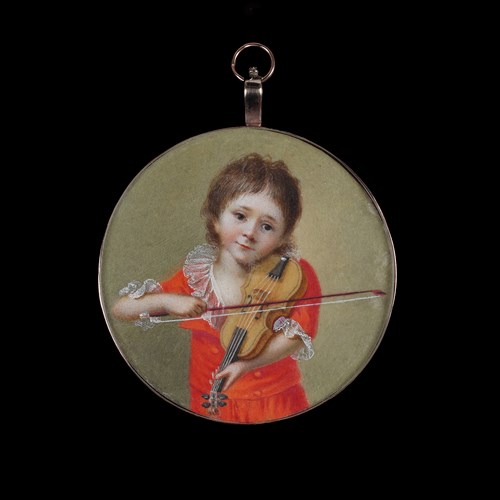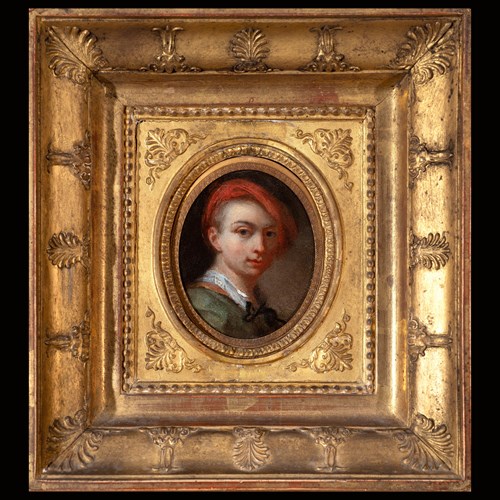Marketplace
Portrait miniature of King Charles II in armour, wearing lace cravat and the blue ribbon of The Order of the Garter
NICHOLAS DIXON
Portrait miniature of King Charles II in armour, wearing lace cravat and the blue ribbon of The Order of the Garter
The Limner Company : Portrait Miniature
Date Circa 1680
Medium Watercolour on vellum laid down on card
Dimension 9.2 cm (3⁵/₈ inches)
The young Nicholas Dixon, who had become the King’s Limner in 1673 following the death of his predecessor, Samuel Cooper (1609-1672), was responsible for the painting of numerous portrait miniatures to the King. This particular example is a version of a portrait by John Riley (1646-1691), also a King’s painter, and comes from the years closer to Charles II’s death. The King is depicted without his distinctive moustache and looks older than he did in the portraits by Lely and Kneller from previous decades.
Riley had been the King’s painter between 1681 and 1691, taking over from Peter Lely upon his death. It is recorded that upon seeing a portrait of himself by Riley, the King had once exclaimed, ‘Is this like me? Odd’s Fish, then I’m an Ugly fellow’[1]. There are a few variations of Riley’s portrait, and the present work is taken from his armour portrait. The exact style of the armour matches closely with the painting attributed to the studio of Riley in the National Portrait Gallery (NPG 3798).
Imagery was extremely important to Charles throughout his reign. He had grown up surrounded by Civil War, and his father, Charles I, had been executed in 1649. Two years later, Charles II was crowned at Scone, however, his reign did not last, and following his defeat at Worcester by Cromwell. From 1651 to 1660, he lived in exile, and portrait miniatures became an important tool through which he could maintain his influence and image amongst loyal Britons. Many of the earlier miniatures taken of Charles, by artists such as Cooper and Des Granges, were painted as gifts for exactly this reason, and were ideal, given their small size and how easy it could be to hide them. The magnificence of this particular ‘miniature’ is unusual in that it is almost twice the size of standard miniatures of this date and may have originally been intended to hang as an imposing centrepiece in a picture cabinet.
During the 1680s, much of Charles’s political effort was spent on religious matters. His heir was his brother, James, Duke of York (1633-1701), and many members of parliament opposed him potentially taking on the throne due to his Catholic loyalties. The Exclusion Bill was made in an attempt to stop this, and some even supported the accession of his illegitimate son, the protestant Duke of Monmouth, over James. Despite efforts to prevent James from inheriting the throne, Charles remained opposed to the Exclusion Bill. Gibson, in her thesis, suggests that portraits of this type, with the King in armour, were intended to make him appear to be more protestant, and to be less unflattering, to swing the opinions of those so opposed to Catholicism. It seems, then, that Riley’s original portrait may have been painted along the same mantra of ‘warts and all’ that Oliver Cromwell had encouraged during his period of rule
[1] Quoted in K. Gibson, “The Best Belov’d of Kings”: The Iconography of Charles II, 1997, (unpublished Ph.D thesis), vol.1, p.133.
Riley had been the King’s painter between 1681 and 1691, taking over from Peter Lely upon his death. It is recorded that upon seeing a portrait of himself by Riley, the King had once exclaimed, ‘Is this like me? Odd’s Fish, then I’m an Ugly fellow’[1]. There are a few variations of Riley’s portrait, and the present work is taken from his armour portrait. The exact style of the armour matches closely with the painting attributed to the studio of Riley in the National Portrait Gallery (NPG 3798).
Imagery was extremely important to Charles throughout his reign. He had grown up surrounded by Civil War, and his father, Charles I, had been executed in 1649. Two years later, Charles II was crowned at Scone, however, his reign did not last, and following his defeat at Worcester by Cromwell. From 1651 to 1660, he lived in exile, and portrait miniatures became an important tool through which he could maintain his influence and image amongst loyal Britons. Many of the earlier miniatures taken of Charles, by artists such as Cooper and Des Granges, were painted as gifts for exactly this reason, and were ideal, given their small size and how easy it could be to hide them. The magnificence of this particular ‘miniature’ is unusual in that it is almost twice the size of standard miniatures of this date and may have originally been intended to hang as an imposing centrepiece in a picture cabinet.
During the 1680s, much of Charles’s political effort was spent on religious matters. His heir was his brother, James, Duke of York (1633-1701), and many members of parliament opposed him potentially taking on the throne due to his Catholic loyalties. The Exclusion Bill was made in an attempt to stop this, and some even supported the accession of his illegitimate son, the protestant Duke of Monmouth, over James. Despite efforts to prevent James from inheriting the throne, Charles remained opposed to the Exclusion Bill. Gibson, in her thesis, suggests that portraits of this type, with the King in armour, were intended to make him appear to be more protestant, and to be less unflattering, to swing the opinions of those so opposed to Catholicism. It seems, then, that Riley’s original portrait may have been painted along the same mantra of ‘warts and all’ that Oliver Cromwell had encouraged during his period of rule
[1] Quoted in K. Gibson, “The Best Belov’d of Kings”: The Iconography of Charles II, 1997, (unpublished Ph.D thesis), vol.1, p.133.
Date: Circa 1680
Medium: Watercolour on vellum laid down on card
Dimension: 9.2 cm (3⁵/₈ inches)
Provenance: Sotheby’s, London, 28 April 1981, lot 108;
Private collection.
Literature: K. Gibson, “The Best Belov’d of Kings”: The Iconography of Charles II, 1997, (unpublished Ph.D thesis), vol.2, p.343, no.778 (listed as present whereabouts unknown).
More artworks from the Gallery





, wearing a dove grey coat and a white cravat, his hair worn down and cu_T638814186814294672.JPG?width=500&height=500&mode=pad&scale=both&qlt=90&format=jpg)



